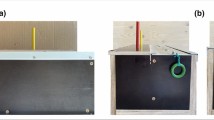Abstract
The process of acquisition and propagation of a novel behavior pattern in a group of 18Lemur catta was examined. Six of eight animals that acquired the new habit were infants or juveniles. Adult males did not take up the new behavior pattern. Effects of rank and kinship on the aquisition process were not obvious.
Similar content being viewed by others
References
Budnitz, N. &K. Dainis, 1975.Lemur catta: ecology and behavior. In:Lemur Biology,I. Tattersall &R. W. Sussman (eds.), Plenum Press, New York, pp. 219–235.
Cambefort, J. P., 1981. A comparative study of culturally transmitted pattern of feeding habits in the chacma baboon (Papio ursinus) and the vervet monkey (Cercopithecus aethiops).Folia Primatl., 36: 243–263.
Ehrlich, A. &J. L. Fobes, 1976. Prosimian learning capacities.J. Human Evol., 5: 599–617.
Evans, C. S. &R. W. Goy, 1968. Social behavior and reproductive cycles in captive ring-tailed lemurs (Lemur catta).J. Zool., 156: 181–197.
Feldman, D. W. &P. H. Klopfer, 1972. A study of observational learning in lemurs.Zeitschrift Tierpsychol., 30: 297–304.
Ganzhorn, J. U., 1985. Habitat use and feeding behavior ofLemur catta andLemur fulvus. Ph.D. thesis, Univ. of Tübingen.
Hosey, G. R. &R. J. Thompson, 1985. Grooming and touching behavior in captive ring-tailed lemurs (Lemur catta, L.).Primates, 26: 95–98.
Itani, J., 1958. On the acquisition and propagation of a new food habit in the natural group of the Japanese monkey at Takasaki-yama.Primates, 1: 84–98.
Jolly, A., 1966.Lemur Behavior. Chicago Univ. Press, Chicago.
—, 1972.The Evolution of Primate Behavior. Macmillan Co., New York.
—, 1985. The evolution of primate behavior.Amer. Scientist, 73: 230–239.
Kawai, M., 1963. On the newly acquired behaviors of the natural troop of Japanese monkeys on Koshima Island.Primates, 4(1): 113–115.
—, 1965. Newly acquired pre-cultural behavior of the natural troop of Japanese monkeys on Koshima Islet.Primates, 6: 1–30.
Kawamura, S., 1959. The process of sub-culture propagation among Japanese macaques.Primates, 2: 43–61.
Ohta, H., H. Ishida, &S. Matano, 1984. Learning set formation in ring-tailed lemurs (Lemur catta).Folia Primatol., 43: 53–58.
Sussman, R. W., 1974. Ecological distinctions in sympatric species of lemur. In:Prosimian Biology,R. D. Martin,G. A. Doyle, &A. C. Walker (eds.), Duckworth, London, pp. 75–108.
Tsumori, A., 1967. Newly acquired behavior and social interactions of Japanese monkeys. In:Social Communication Among Primates,S. A. Altmann (ed.), Univ. Chicago Press, Chicago, pp. 207–219.
Author information
Authors and Affiliations
About this article
Cite this article
Kappeler, P.M. The acquisition process of a novel behavior pattern in a group of ring-tailed lemurs (Lemur catta). Primates 28, 225–228 (1987). https://doi.org/10.1007/BF02382571
Received:
Accepted:
Issue Date:
DOI: https://doi.org/10.1007/BF02382571




